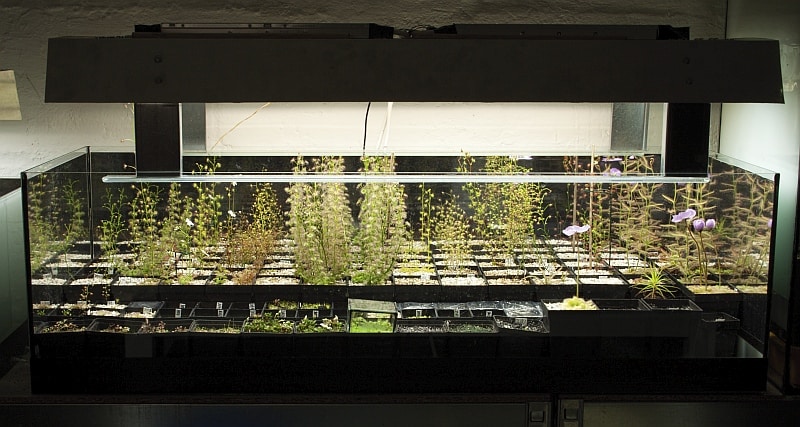When you want to start cultivating tuberous Drosera, the first thing you usually think about is where you get the tubers or seeds from. That's a very legitimate question, but the first question must be: "Can I create the conditions to cultivate tuberous Drosera? There is no point in having beautiful tubers that are dead after four weeks because you have not considered something or some seeds that will never germinate because the conditions under which they can germinate are not fulfilled.
Gain Experience
I strongly recommend to first gain experience with the culture of simple Drosera, then perhaps with pygmy Drosera and in the best case already with simple winter growing south African Drosera (in that order). In this case the culture of tuberous Drosera will probably succeed very well. If you want to start immediately with tuberous Drosera, this is a clear challenge. On all my websites I assume that you have already gathered the above mentioned experiences and successfully cultivated at least simple Drosera.
Prerequisites for the Culture of Tuberous Drosera
Here a short summary, what you should already have:
lime-free sand and gravel in grain size 0.5 - 2 mm (0.2 to 0.8")
lime-free or very low lime water
unfertilised white peat with medium degree of decomposition
High pots
A light source of a suitable light colour and with sufficient power (if you don't own a greenhouse)
This gives you almost everything you need for a successful culture. Only one thing is missing: a suitable location. Tuberous Drosera like it cool in winter. Day temperatures should not exceed 20 °C (68°F) and at night ideally around 10 °C (50°F), but it may be cooler, but not much warmer. If you do not have a greenhouse, the cellar or the attic are particularly suitable. It is also possible to have a cool or only moderately heated room. If you has a terrace or a balcony with a halfway southern orientation, this is not bad for the beginning and the end of the growth phase, thus in autumn and in spring, either.
All this is described in more detail on the page Potting in and out.
A simple Setup
Here is the picture of a simple setup for tuberous Drosera that I had in my cellar in 2010. At the end it is an aquarium, where I set the lights a little bit higher, so that the plants can grow and the heat of the fluorescent tubes is dissipated. I exchanged the aquarium fluorescent tubes for others with a suitable light colour and glued mirror foil to the sides.
With such an aquarium you can get more than 50 pots down and the tuberous Drosera grow quite well in it. Experienced growers see the defects immediately. This is not so good for tall species, at least not when the plants are fully grown and also not for taller pots. The lighting generally seems to be a bit too little and especially in the corners not really good but it worked well for years. By the way, the beautiful pink flowers are not tuberous Drosera but from Drosera pauciflora, a winter growing south African species, which can be kept very well under these conditions.

Now we come to the question with what kind of species to start and whether you should start with tubers or seeds. The answer is: with both (if that's possible)!
Tubers
The tubers have the advantage that you can see very quickly results (i.e. next winter and if the conditions are right), i.e. in the ideal case beautiful, full-grown and possibly maybe flowering plants and that you can have possibly already a few daughter tubers in the next season. The disadvantage is that it can be just in the beginning that you make mistakes and the tubers die and then you may have lost the species completely. That's why I only recommend species that reproduce well to very well and are available in appropriate quantities At least in the EU.
Drosera stolinifera Drosera abberans Drosera platypoda Drosera erythrorhiza Drosera magna Drosera menziesii Drosera hookeri
Please do not understand the list as "only these species are suitable for beginners". There are also a few other species and if in doubt you should ask the seller in the forum, preferably by briefly describing your setup for the culture. With commercial traders this is of course difficult.
Often upright species such as tubers from the Drosera peltata complex or Drosera auriculata are also recommended. These are very nice species to start with seeds, but as they grow very high (0.5 m (1ft 8") and larger are not uncommon with half grown plants) they can cause difficulties especially for beginners because of their height. But if you have a greenhouse, it works very well.
I believe it is likely that some tubers will die until you have a "feeling" for what you have to do when or, to put it another way, the experience. Don't let this discourage you!
Seeds
Seeds have the advantage that you can get relatively inexpensive and fast many plants and that these plants will also form seeds later, if you pollinate them among each other. The disadvantage is on the one hand that the tubers formed after the first season are still very small and therefore quite sensitive to dehydration and that it takes a few years until you have beautiful adult plants.
Drosera auriculata Drosera peltata Drosera hookeri (ex. Drosera peltata var. foliosa) Drosera macrantha Drosera planchonii Drosera gracilis (ex.Drosera peltata var. gracilis)
Maybe you're wondering now because they're just upright growing species. These species do not need any heat stratification, germinate when they are fresh, usually very good and numerous and are generally not so sensitive. The rosy species usually have very thick seeds and it is difficult to germinate them. This can take 2-3 years with the more difficult species and that might not be a good start to look at the possibly mossy substrate surface for three years.